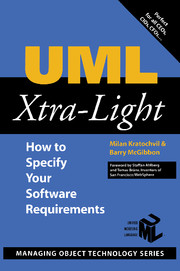Book contents
- Frontmatter
- Contents
- Foreword
- Preface
- Acknowledgments
- About the Authors
- How to Customize This Book
- Chapter 1 Introduction
- Chapter 2 Aligning to the Business
- Chapter 3 Adding Rigor to the Requirements
- Chapter 4 Sketching the Inside Structure
- Chapter 5 Sketching the Inside Dynamics
- Chapter 6 Moving Toward Components
- Chapter 7 Mapping from Classes to Data Models
- Chapter 8 Concluding Remarks
- Some Suggested Readings
- Index
Chapter 1 - Introduction
Published online by Cambridge University Press: 14 October 2009
- Frontmatter
- Contents
- Foreword
- Preface
- Acknowledgments
- About the Authors
- How to Customize This Book
- Chapter 1 Introduction
- Chapter 2 Aligning to the Business
- Chapter 3 Adding Rigor to the Requirements
- Chapter 4 Sketching the Inside Structure
- Chapter 5 Sketching the Inside Dynamics
- Chapter 6 Moving Toward Components
- Chapter 7 Mapping from Classes to Data Models
- Chapter 8 Concluding Remarks
- Some Suggested Readings
- Index
Summary
Software – Yet Another Knowledge Industry
Knowledge industries such as electronics, space, pharmaceuticals, or software are special. On the surface, they're the hotly-argued-upon backbone of the new economy, a concept that's no longer new. In our opinion, it's the approach to business that makes the difference, rather than a company's niche or age. Some old-economy veterans, such as global-automation vendor ABB, have rapidly expanded their R&D initiatives and resources, employing many more IT specialists than many so-called new high-profile IT firms. IT provides a foundation to a variety of current business ideas, including customer-driven manufacturing where a web customer configures the product or even the software guiding an industrial robot in manufacturing the chosen customized product.
Obviously, knowledge industries are more special under the shell than at this slightly superficial mass-media/thematic level. On one hand, they have business processes similar to other industries but, on the other hand, production/operations is a small part of any business dominated by R&D and by marketing the know-how of that organization.
Awareness of knowledge-industry specifics is a project-time saver, both within the software industry itself and with the rapidly increasing number of its customers in the other knowledge industries. Knowledge industries are often interleaved with traditional industry sectors – today, you find computer chips and software in all the flagships of industrialism, from heavy trucks to railways. But, in a high-tech region, the complete knowledge-business value chain can sometimes grow remarkably long without any tangible (“hard”) products whatsoever (Figure 1-1).
- Type
- Chapter
- Information
- UML Xtra-LightHow to Specify Your Software Requirements, pp. 1 - 12Publisher: Cambridge University PressPrint publication year: 2002

